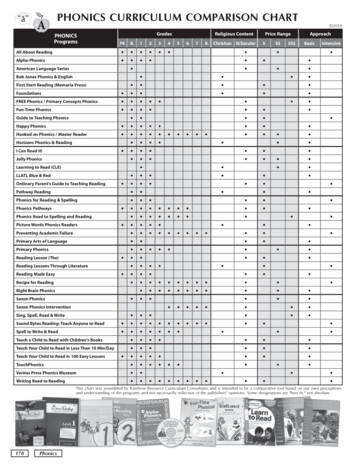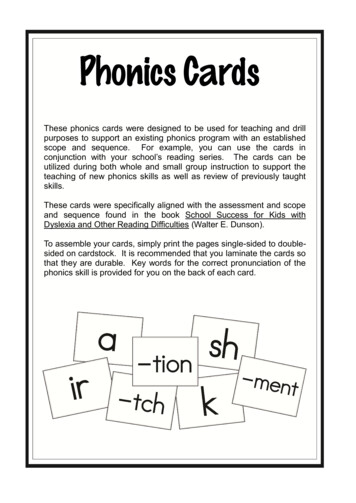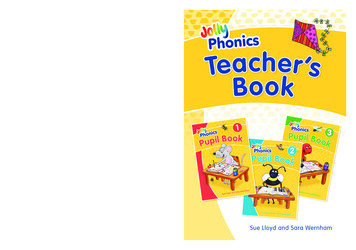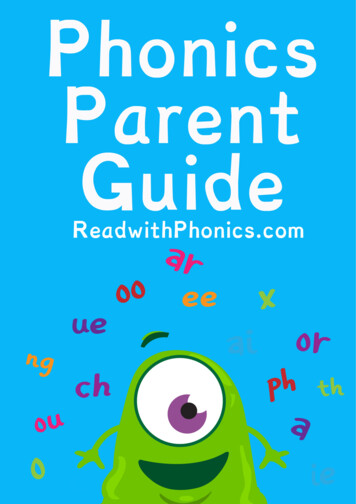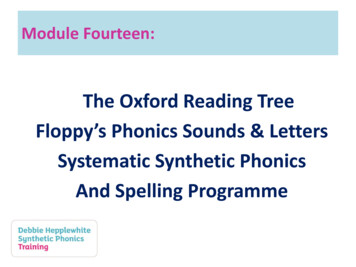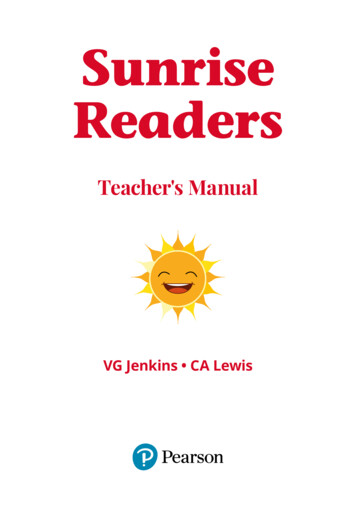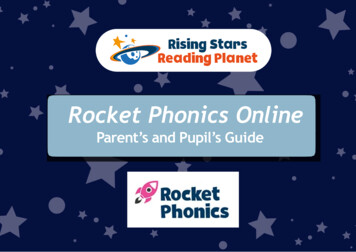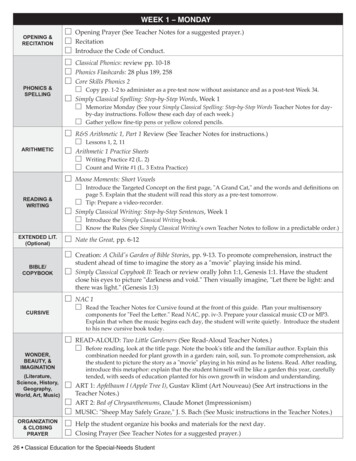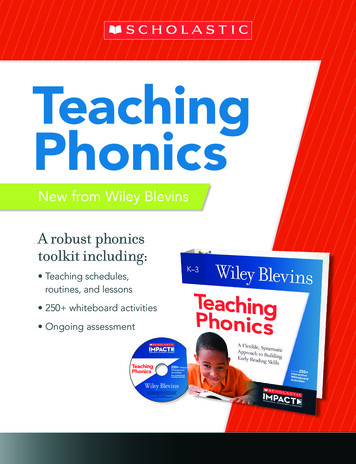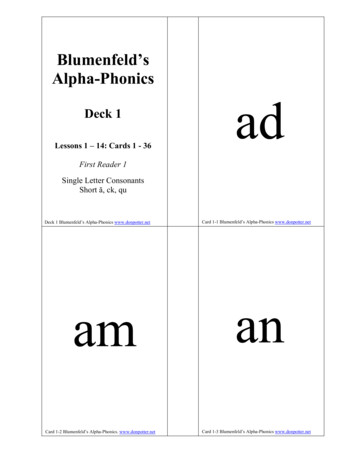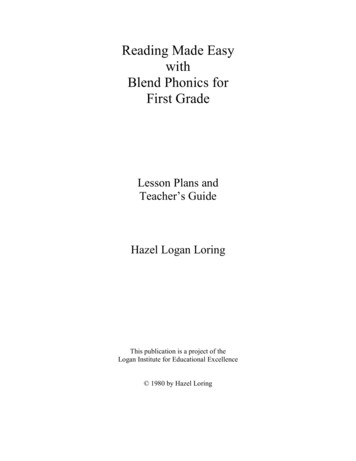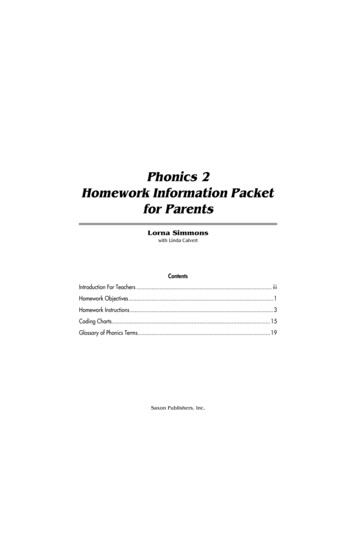
Transcription
P2 HW Title page/Cover letter Page i Wednesday, October 14, 1998 9:24 AMPhonics 2Homework Information Packetfor ParentsLorna Simmonswith Linda CalvertContentsIntroduction For Teachers . iiiHomework Objectives.1Homework Instructions .3Coding Charts.15Glossary of Phonics Terms.19Saxon Publishers, Inc.
P2 HW Title page/Cover letter Page ii Wednesday, October 14, 1998 9:24 AMPhonics 2 Homework Information PacketCopyright 1998 by Saxon Publishers, Inc.All rights reserved.Permission is hereby granted to teachers to reprint or photocopy in classroom quantities the sheets in this packet thatcarry a Saxon Publishers copyright notice. These pages aredesigned to be reproduced by teachers for use in theirclasses with accompanying Saxon Publishers material, provided each copy made shows the copyright notice. Such copies may not be sold and further distribution is expresslyprohibited. Except as authorized above, no part of this publication may be reproduced, stored in a retrieval system, ortransmitted in any form or by any means, electronic, mechanical, photocopying, recording, or otherwise, without the priorwritten permission of the publisher.Printed in the United States of America.Editor: Julie WebsterPrepress Manager: Travis RoseProduction Coordinator: Joan ColemanFirst printing: October 1998Reaching us via the InternetWWW: http://www.saxonpub.comE-mail: helpdesk@saxonpub.comSaxon Publishers, Inc.2450 John Saxon Blvd.Norman, OK 73071
P2 HW Title page/Cover letter Page iii Wednesday, October 14, 1998 9:24 AMPhonics 2 Homework Information PacketIntroduction For TeachersThis packet is designed to educate parents about Saxon Publishers’ Phonics 2 program—specifically, thephonics homework. Most parents will be extremely interested in helping their child learn how to read. Ifunfamiliar with phonics, however, parents may express confusion or anxiety about how to help. Many parents will simply require reassurance from the teacher, but some will want more explanation about phonicsconcepts or specific instructions for completing the homework. This packet is designed to address some ofthese concerns. It contains the following: Four simple rules parents can follow to help their child complete the homework Instructions for completing each homework page More in-depth explanations of selected concepts Charts listing vowel and spelling rules, syllable division patterns, letter clusters, and coding marks Glossary of phonics termsUse of this information packet is entirely optional. Teachers may send the packet home in its entirety orchoose only portions. Some teachers will send packets only when parents request more information. A fewdifferent methods of packet distribution are suggested below: Send home a packet with each student at the beginning of the year. Attach a note suggesting thatparents refer to the packet throughout the year as they supervise phonics homework.Distribute packets directly to parents at Open House or during parent/teacher conferences along withsuggestions for use. Consider conducting a brief phonics lesson to further explain the program.Send home appropriate portions of the packet on a weekly or even daily basis. For instance, sendhome the instructions for Homework 1–4 during the week those lessons are taught.Send packets (or portions of packets) only to those parents who request more information about phonetic coding and concepts.This packet is not intended to replace classroom instruction. Parents should not feel obligated to teachthe concepts described herein since they will be covered extensively in class. Furthermore, it is recommended that parents not attempt to read the entire packet in one sitting.Besides sharing the contents of this packet, teachers might try several other things to ease parents’ anxieties: Make sure the worksheet (i.e., front side) is completely corrected before sending it home. Studentsand parents will refer to this side when completing the homework.Clearly explain instructions and identify any pictures before sending homework home.Copyright by Saxon Publishers, Inc. and Lorna Simmons.iii
P2 HW Title page/Cover letter Page iv Wednesday, October 14, 1998 9:24 AMPhonics 2 Homework Information Packet Encourage children to teach the coding and concepts they’ve learned to their parents. This not onlyhelps reinforce learning, but it also keeps parents informed about the program.Emphasize to parents the importance of reading with their child. It is much more important that theyspend time blending sounds and reading with their child than it is for them to worry about coding.If homework is still causing too many difficulties, consider having students complete it in class sometime later in the day.Above all, remember that the ultimate goal of phonics instruction is for students to learn how to read, notto learn to code perfectly. Reassure parents who express concern by explaining that homework is nevergraded. It simply serves the following purposes: (1) It provides teachers with a diagnostic tool to judgewhat concepts need more review. (2) It provides students with further practice. (3) And it provides parents with a means to evaluate their child’s progress in learning how to read.ivCopyright by Saxon Publishers, Inc. and Lorna Simmons.
Phonics 2 Homework Information PacketHOMEWORK OBJECTIVES(1) To allow children the opportunity to practice reading at home to parents, guardians, or older siblingsusing materials that follow the sequence of letter presentation being presented at school.(2) To allow parents to see how their child is progressing.FOUR SIMPLE STEPS TO HELP YOUR CHILD COMPLETE PHONICS HOMEWORK(1) Allow your child to code any words needed in order to read them. Your child may refer to the frontside of the worksheet for similar coding examples. Do not be concerned about correcting the codingmarks because these will be discussed thoroughly in class. The overall purpose of phonics coding is toact as a tool to help children read unfamiliar words. Some children will not master coding the day it istaught; other children will not even need coding in order to read. The overall goal of phonics is not toteach children how to code but how to read.(2) Listen to your child read as many words, sentences, and paragraphs on the homework as possible. Insections containing sentences/paragraphs, your child need code only those words that pose difficulty.(3) If your child blends and reads words fairly well, have him or her practice reading the homework andthen answer any questions. However, if your child struggles to read single words, he or she won’t beable to read sentences or paragraphs. In this event, do not force your child to read the sentences andparagraphs on the homework; instead, follow the suggestions below:(a) If reading single words (i.e., blending sounds) is difficult for your child, point to individual lettersin words and ask your child to identify the sounds those letters make. For example, in the word“mat,” the sounds are /m/ /a/ /t/. Demonstrate slowly how to blend the sounds. Do not sayeach sound in isolation, but try to hold on to each one before starting the next. For example,mmmaaaat. (Some sounds are harder to sustain, like /k/ and /t/.) Some children require quite a bitof demonstration before the “light comes on” and they learn to blend independently. (Helpingyour child learn to blend is important, especially since teachers of large classrooms cannot alwaysfind sufficient time to work with individual children.)(b) If your child can read single words but is still mastering the blending process, encourage him or herto read the sentences and/or paragraphs. Keep in mind, however, that your child’s level of readingcomprehension may be low at this stage. Until the reading process becomes more automatic, helpyour child work on comprehension by reading any sentences or paragraphs to your child and havinghim or her answer the questions.(4) Return homework the following school day. This practice not only helps your child’s teacher determine whether your child is getting appropriate help at home, but it also helps your child developresponsibility.Copyright by Saxon Publishers, Inc. and Lorna Simmons.1
Phonics 2 Homework Information PacketHomework InstructionsThe following contains a brief introduction to major phonics concepts and coding as well as instructions forcompleting specific homework pages. Use these instructions in conjunction with the parent notes at thebottom of each homework page. This information is provided to help keep you informed about what yourchild is learning in class.When helping your child complete the homework, remember a few key points. First, the homework side(back) always mirrors the worksheet side (front); the worksheet will have been completed and correctedin class, so you may always refer to it for similar examples or coding. Second, instructions are not printed onthe homework because it is important that your child not be asked to read with letters or concepts thathaven’t been taught; however, your child’s teacher will have explained all necessary instructions for completing the homework and will have identified any pictures. Third, once a concept or coding is introduced,it is practiced in all subsequent lessons. Finally, do not worry about the coding. The coding marks will beexplained during class time. The most important thing is that you spend time working with and listening toyour child read. Daily reading practice is essential for future reading success.First week(Lessons 1–5,which have nohomework)First vowel rule: When a vowel is followed by a consonant, the vowel is short.Code the vowel with a breve. A breve looks like a smile:taphelpinstopsunTwin consonants: Two adjacent letters that are just alike; they make only onesound. In Phonics K and Phonics 1, your child was taught to cross out the second consonant as a reminder that the sound is pronounced only once. Although this coding isno longer required in second grade, your child may continue to use it. Thus:pill (or pilÒ)inn (or in )K-back: A vertical line on the back of a c representing the /k/ sound, as in “cat.”This week your child also learned the /k/ sound of the letter c and how to code it.(The /s/ sound will be taught in Lesson 63.)cr op catHomework 6and 7Second vowel rule: An accented vowel not followed by a consonant is long. Codethe vowel with a macron and an accent mark. A macron is simply an overline:AÆbEÆhIÆsOÆflUÆCode and read each word. Draw lines from the pictures to the matching words.Homework 8Spelling with c and k: Today your child learned how to spell the /k/ sound in the initial position. The spelling rule is stated below:When spelling the /k/ sound in the initial position,Use the letter k before the letters e, i, or y, as in “kept,” “kit,” or “sky.”Use the letter c before the letters a, o, u, or any consonant, as in “cat,”“cot,” “cup,” or “clip.”Using the spelling rule, write the correct spelling of the /k/ sound for each word. Thencode and read each word.Copyright by Saxon Publishers, Inc. and Lorna Simmons.3
Phonics 2 Homework Information PacketHomework 9Syllable division: The breaking of a word into separate syllables to make decoding(pronunciation) easier. Today your child learned the first syllable division pattern,often referred to as the “vowel, consonant, consonant, vowel” pattern, or “vccv” pattern. Follow the steps below to help your child identify syllable division patterns:Identifying Syllable Division PatternsASK CHILDCHILD WILL THENEXAMPLE1. Are there any suffixes?†Box any suffixes.n a p k i n s 2. Where are the vowels?Write small v’s under the vowels.n a p k i n s 3. What’s between the vowels?Write small c’s under the consonants between the vowels.n a p k i n s 4. Where do we divide?Divide between the consonants. (May change in other patterns.)n a p\k i n s 5. Which syllable is accented?Accent the first syllable. (May change in other patterns.)n a pÆ\k i n s 6. How do we code this word?Code the vowels, k-backs, etc., within each syllable.n a pÆ\k i n s 7. How do we read this word?Read each syllable individually; then blend the syllablestogether, accenting the appropriate syllable.napkins8. Is this a word you know?If the word doesn’t sound right, move the accent to the second syllable and try again.u n\ t i lÆvvv c cvv c cvv c cvv c cvv c cv†Suffixes aren’t introduced until Lesson 33. Until that lesson, skip this first step.Two important points to remember with syllable division patterns are always to boxthe suffix first and to label only those consonants that fall within the vowel pattern. In later lessons, your child will learn more syllable division patterns:Additional Syllable Division PatternsLESSONPATTERNEXAMPLENOTES66vc\cvcÆ\cvâ t \l a nÆ\ t i c Notice that this is two overlapping “vccv” patterns.81vÆ\cvr AÆ\v » nThe vowel usually makes a long sound in an open,accented syllable. (“Open” means the vowel isn’tfollowed by a consonant in that syllable.)91–92vcÆ\vr i vÆ\e r 97vc\ccvÆvccÆ\cvv cc v c cvv c vvc vi n\s p e c tÆv c c c va t hÆ\l E t v c c c vThe letter a usually makes a schwa (short u) soundin an open, unaccented syllable.«\g OÆv\cvÆGenerally, digraphs and blends should remaintogether in the same syllable.v c v111–112v\cvÆ4E\l e c tÆvc vO\m i tÆv c vU\n I t Æv c vThe letters e, o, and u usually make long sounds inopen, unaccented syllables.Copyright by Saxon Publishers, Inc. and Lorna Simmons.
Phonics 2 Homework Information PacketAdditional Syllable Division Patterns inued)v\cvÆd i\v I d ÆThe letter i usually makes a short sound in an open,unaccented syllable.119vÆ\ccvvcc\vÆvÆ\vv\vÆv\v129vcv tÆr E\ s p e cv c c vd IÆ\» tv váÆ\p r i lThis is another variation of the “vccv” pattern.v c cvc r E\A t Æv v c a m\E \Ov c v vNotice that some words contain more than onesyllable division pattern.Code and read the words. Draw lines to the matching pictures. (Refer to examples onthe front for help with the syllable division.)Homework 11Digraph: Two letters that come together to make one sound. Code digraphs byunderlining them. Today your child learned digraph ck. In this digraph, the c iscrossed out because the /k/ sound is pronounced only once.snaCKThe following digraphs (and coding) will be taught throughout the year:Additional TH (unvoiced)† CHcheese62ÄYhay16C H /k/çH /sh/chordchef86ÖA, ÖEsoap, 1NGlung102èWcashew52PHphone106ËYkey53ËA /E/ëA /e/EÄ /A/leafthreadbreak108ÜEglue56KN /n/†GN /n/WR /r/knifegnatwreath11757OÜsoupËI /E/èÌ /A/ìE /I/IË /E/receiptveilpieshield†These three digraphs are often referred to as “ghost letter” digraphs since they contain letter sounds no longer pronounced.Copyright by Saxon Publishers, Inc. and Lorna Simmons.5
Phonics 2 Homework Information PacketHomework 11(continued)Spelling with final ck: Today your child also learned when to use the letters ck tospell the /k/ sound in the final position. The spelling rule is stated below:When spelling the /k/ sound in the final position,Use ck after a short vowel sound, as in “stick” or “track.”Code and read the words. Draw lines to the matching pictures.Homework 12Voiced sound: One that requires the use of the vocal cords; a vibration is felt.Today your child learned the voiced and unvoiced sounds of digraph th. The voiceddigraph is coded with a line through it (called a voice line).†an†atcompared to†EÆmaTHwiTHCode and read the words. Draw lines to the matching pictures.Except where indicated, Homework 13 through 140 will contain any of the following elements: (1) Codeand read the single words. (2) Draw lines to the matching pictures. (3) Read the sentences/paragraphsand answer any questions.Homework 13Notice that your child begins reading sentences on this homework. This will eventually progress to entire paragraphs. On these reading portions of the homework, your childneed code only those words that prove difficult.Homework 14Schwa: A coding mark placed over a vowel to indicate the short u sound. Todayyour child learned that the word “the” is often pronounced with a schwa sound (asopposed to the long e sound). To code a schwa sound, write an upside-down e over thevowel (or just make a circle with a line through it):†» hot panHomework 16Cedilla: A coding mark on the letter c used to indicate its soft sound, as in “cent.”Today your child learned two additional sounds of digraph ch—the /k/ sound, as in“chord,” and the /sh/ sound, as in “chef.” Code the /k/ sound of c with a k-back andthe /sh/ sound with a cedilla (a small hook making the c look like an s). As always,digraphs are also underlined. ChrisHomework 17çhefToday your child learned a second voiced sound—the /z/ sound of the letter s. Codingthis sound with a voice line is optional in Phonics 2. Thus:haß (or has)6Copyright by Saxon Publishers, Inc. and Lorna Simmons.
Phonics 2 Homework Information PacketHomework 18Combination: Two letters that come together to make an unexpected sound. Codecombinations with arcs. Today your child learned combination er.fer nThe following combinations (and coding) will be taught throughout the year:Additional IONEXAMPLE19ir¡shirt24ar †dollar21ur purse26or fork22qu§quail27or ‡doctor23ar arm28wh whale†When combination ar falls in an unaccented syllable, it makes the /er/ sound.‡Combination or also makes the /er/ sound in an unaccented syllable.Homework 31Sight word: A word in which all or part does not follow phonetic rules. Approximately 120 sight words will be taught throughout the year. These are introduced ingroups of ten. After each group of words is introduced, it is suggested that you printeach word neatly on an index card and review it with your child. Continue to add tothe deck as new words are introduced, removing words only when your child caninstantly recognize them.Sight Words†LESSONWORDS31are, from, of, said, says, want, was, were, what, where41come, didn’t, do, does, don’t, one, put, some, to, who54been, could, four, goes, other, should, their, there, they, would64any, brother, buy, father, learn, many, mother, ocean, sure, trouble74again, door, enough, friend, give, have, only, talk, walk, young84country, early, earth, eye, fought, heard, two, whose, woman, women94cousin, gone, guard, guess, half, island, laugh, listen, mountain, once104bought, brought, busy, cough, done, rough, though, thought, through, tough114certain, climb, floor, fruit, move, often, push, shoe, sign, warm124answer, build, caught, clothes, February, heart, nothing, shoulder, straight, sugar134beautiful, Dr., full, measure, Mrs., none, poor, prove, special, stomach139aunt, course, daughter, hour, Mr., Ms., pour, pull, touch, Wednesday†Although sight words were circled in Phonics 1, this coding is optional in Phonics 2.Homework 32“Wild Colt” words: One-syllable words containing the letter i or o followed bytwo consonants; the vowels are often pronounced with their long sounds. Pleasenote that some exceptions may occur. (Compare wind to wInd.)wIldCopyright by Saxon Publishers, Inc. and Lorna Simmons. cOltOldpIntfOlds cOldblInd7
Phonics 2 Homework Information PacketHomework 33Suffixes: A letter or group of letters added to the end of a root word that changesthe meaning or usage of the word. Code suffixes by boxing them,† thus distinguishing the root word from the suffix.kids boxÆ ingflfullÆness The following suffixes will be taught throughout the year:SuffixesLESSONSUFFIXLESSONSUFFIX33-s, -ed, -ing, -less107-es59-er, -est, -y109-ous69-let, -ly122-en, -ish, -ist82-ful, -ness132-ageIf your child tries to box the s in words like “is” or “his,” or the ing in words like “sing,”explain that a root word must remain after boxing the suffix. Furthermore, boxing thesuffix shouldn’t change the vowel sound (as it would if you boxed the s in “his.”)Note: After this lesson, boxing suffixes will become the first step when identifyingsyllable division patterns. (Please see the table “Identifying Syllable Division Patterns” on page 4.)Homework 34Floss rule: The letters f, l, and s are doubled after a short vowel in a one-syllableroot word. For example:flossHomework 36hissballThird vowel rule: A vowel followed by a consonant and sneaky e is long. Code thevowel with a macron and cross out the sneaky e. For example:nAm hOp THEm lIk rUl Sneaky e occurs at the end of a root word. This concept is taught by explaining thatthe sneaky e “sneaks” past the consonant, “scaring” the vowel into making its longsound. (The rule may also be applied to words with suffixes, like “nameless”; box thesuffix and code “name” as shown above.)Homework 39Spelling with final k: Today your child learned a second way to spell the /k/ sound inthe final position. The spelling rule is stated below:When spelling the /k/ sound in the final position,Use k after two adjacent vowels or after a consonant, as in “book” and“peek” or “milk” and “brisk.”Using the spelling rule, finish spelling the words. Then code and read them.Homework 41Add more cards to your sight word deck. (See the word list on page 7.)†Coding within suffix boxes (such as a voiced s) is not required in Phonics 2.8Copyright by Saxon Publishers, Inc. and Lorna Simmons.
Phonics 2 Homework Information PacketHomework 42through 44Final, stable syllable: A nonphonetic syllable that occurs in the final position frequently enough to be considered stable. Two-syllable words that end in final, stablesyllables are not coded with syllable division patterns. Instead, the final syllable isbracketed off, the e is crossed out, and the syllable before the bracket is accented. Forexample:tAÆ[bl rufÆ[fl botÆ[tl In Lessons 42–44, your child will learn the following final, stable syllables: -ble, -fle,-ple, -dle, -tle, -gle, -cle, -zle, -sle, and -kle. Other final, stable syllables that will betaught throughout the year are listed below:Additional Final, Stable SyllablesHomework 46LESSONFINAL, STABLE SYLLABLEEXAMPLE83[tionlotion101[sionmansion; television113[cious; [tiousdelicious; nutritious116Others that begin with “ci,” “si,” and “ti”(usually followed by “al,” “an,” or “ent”)crucial; Martian;patient; Persian123[turepictureSpelling with final ke: Today your child learned a third way to spell the /k/ sound inthe final position. The spelling rule is stated below:When spelling the /k/ sound in the final position,Use ke after a long vowel, as in “cake” or “fluke.”Spelling with final ve: Your child also learned how to spell the /v/ sound in the finalposition. Again, the spelling rule is stated below:When spelling the /v/ sound in the final position,Use the letters ve, as in “have” or “live.”Using the spelling rules, finish spelling the words. Then code and read them.Homework 47and 48Vowel y: Your child has learned that y can act as a vowel. When vowel y sounds likea long e, it is coded with a dot. When it sounds like a long i, it is coded with both a dotand a macron. For example: crŒÆsup\plŒÆv c cv canÆ\d v cc vTo determine the sound vowel y will make, use the following rules:Vowel y in an accented syllable sounds like a long i, as in “cry” or “supply.”Vowel y in an unaccented syllable sounds like a long e, as in “candy.”Homework 54Add more cards to your sight word deck. (See the word list on page 7.)Copyright by Saxon Publishers, Inc. and Lorna Simmons.9
Phonics 2 Homework Information PacketHomework 57Diphthong: Two vowel sounds that come together so fast that they are consideredone syllable. Like combinations, diphthongs are coded with arcs. Today your childlearned diphthong ou, as in “mouse.” The letters ou can also act as a digraph, as in“soup.” (If you experiment with the two sounds, you’ll notice that your mouth movesslightly when you say the /ow/ sound but doesn’t when you say the /oo/ sound.)Because the letters ou act as a diphthong more often than they act as a digraph, yourchild has been taught to try the /ow/ sound first when reading ou.mou s (diphthong ou)Homework 58sOÜp (digraph ou)Today your child learned another letter cluster that may act as either a diphthong or adigraph—ow. Diphthong ow makes the sound found in “cow,” whereas digraph owmakes the sound found in “low.” Again, your child should try the diphthong pronunciation first when encountering the letters ow.cow (diphthong ow)Homework 63lÖW (digraph ow)Soft c: As mentioned in Lesson 16, the letter c makes both a hard (/k/) and a soft(/s/) sound. C makes its soft sound when it is followed by a “softener” letter—e, i, or y.Code soft c’s with cedillas.ç ir¡Æ[ cl çentçŒÆ[ cl Using the spelling rule, finish spelling the words; then read them. Read the paragraphand answer the questions.Homework 64Add more cards to your sight word deck. (See the word list on page 7.)Homework 66Refer to the table “Additional Syllable Division Patterns” on page 4.Homework 68Two final diphthongs are taught in this lesson—diphthong oi, as in “oil,” and diphthong oy, as in “toy.”Homework 71Trigraph: Three letters that come together to make one sound. Trigraphs are similar to digraphs (and coded the same way). The chart below summarizes the trigraphstaught throughout the Hmatch77D·EbridgeHomework 74Add more cards to your sight word deck. (See the word list on page 7.)Homework 76Soft g: Like the letter c, the letter g makes both a hard (/g/) and a soft (/j/) sound. Gmakes a soft sound before the “softener” letters—e, i, or y. Code soft g’s with dots(reminding your child of the /j/ sound). Please note that some exceptions may occur,such as “get,” “give,” and “gift.” emß œmma Æ\i cv c10vCopyright by Saxon Publishers, Inc. and Lorna Simmons.
Phonics 2 Homework Information PacketHomework 78Spelling the final /j/ sound: Today your child learned how to spell the /j/ sound inthe final position. The spelling rule is stated below:When spelling the /j/ sound in the final position,Use dge after a short vowel, as in “fudge” or “bridge.”Use ge after anything else, as in “bulge,” “stooge,” or “cage.”Using the spelling rule, finish spelling the words; then read them. Read the paragraphand answer the questions.Homework 79Spelling the final /ch/ sound: Today your child learned how to spell the /ch/ soundin the final position. The spelling rule is stated below:When spelling the /ch/ sound in the final position,Use tch after a short vowel, as in “match” or “ditch.”Use ch after anything else, as in “peach” or “bunch.”Using the spelling rule, finish spelling the words; then read them. Read the paragraphand answer the questions.Homework 81Refer to the table “Additional Syllable Division Patterns” on page 4.Homework 84Add more cards to your sight word deck. (See the word list on page 7.)Homework 91and 92Refer to the table “Additional Syllable Division Patterns” on page 4.Homework 93/o/ sound of the letter a, Part 1: When the letter a comes before the letter l, it oftenmakes the short o sound. Code this sound with two dots:sãltwãlkHomework 94Add more cards to your sight word deck. (See the word list on page 7.)Homework 96/o/ sound of the letter a, Part 2: When the letter a comes after the letters w or qu, itoften makes the short o sound. Again, code this sound with two dots:squ§ãdwãTCHHomework 97Refer to the table “Additional Syllable Division Patterns” on page 4.Homework 98Spelling with final c: Today your child learned the final way to spell the /k/ sound inthe final position. The spelling rule is stated below:When spelling the final /k/ sound in a word containing two or more syllables,Use the letter c, as in “plastic” or “majestic.”Using the spelling rule, finish spelling each word; then read it.Homework 99Scribal o: Today your child learned that when the letter o comes before the letters m,n, or v, it often makes a schwa sound and is referred to as a “scribal o.” Code this soundwith a schwa:m nTHCopyright by Saxon Publishers, Inc. and Lorna Simmons.s me (or s m )d ve (or d v )11
Phonics 2 Homework Information PacketHomework 103Doubling rule: When the final syllable of a root word is accented, and it ends withone vowel and one consonant, double the final consonant before adding a vowelsuffix.hit -ing hittinghop -ed hoppedforget -ing forgettingUsing the doubling rule, spell the words; then read them.Homework 104Add more cards to your sight word deck. (See the word list on page 7.)Homework 111and 112Fourth vowel rule: In an open, unaccented syllable, the letter a usually makes aschwa sound, the letters e, o, and u usually make long sounds, and the letter i usually makes a short sound.a:«\bou tÆb«\nanÆ\«e, o, u:E\rAs ÆhO\telÆi:di\vId Æçi\gar ÆJU\lŒÆRefer also to the table “Additional Syllable Division Patterns” on pages 4 and 5.Homework 114Add more cards to your sight word deck. (See the word list on page 7.)Homework 118Quadrigraphs: Four letters that come together to make one sound. Quadrigraphsare similar to digraphs and trigraphs (and coded the same way). Only one quadrigraphis taught—quadrigraph eigh:slèÌGHHomework 119Refer to the table “Additional Syllable Division Patterns” on page 5.Homework 121Dropping rule: When a root word ends with a sneaky or silent e, drop the e beforeadding a vowel suffix.take -ing takingvote -ed votedsolve -ing solvingUsing the dropping rule, spell the words; then read them.Homework 12412Add more cards to your sight word deck
This packet is designed to educate parents about Saxon Publishers' Phonics 2 program—specifically, the phonics homework. Most parents will be extremely interested in helping their child learn how to read. If unfamiliar with phonics, however, parents may express confusion or anxiety about how to help. Many par-
